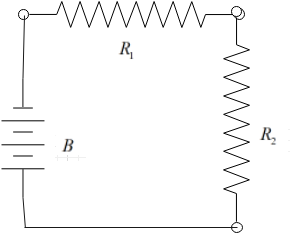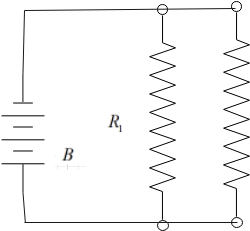
How many branches can a series circuit have?
Answer
481.2k+ views
Hint: We know that there are two types of circuit combination, namely the series and parallel. Accordingly, the load or the resistance offered on the circuit varies. To understand the branching in the series, let us look at the characteristics of the series and parallel circuit.
Complete answer:
We know that an electrical circuit is a closed loop through which electrical current or the charged electrons flow through. It is made up of many electrical components, the most basic or simple electrical circuit, contains the following components, the source or battery, connecting wires, load or resistance and switch.
Now, the load or resistance can either be connected in series or parallel with respect to the source, and hence the total or the net resistance offered by the circuit, varies.
When two or more resistances are connected in series, the total resistance offered by the circuit is the sum of the individual resistances, which is greater than the individual resistance connected in the circuit. Here, the current through all the resistances remains a contestant, as the potential drop across each resistance varies.
A series circuit, looks like the following below:

Similarly, when two or more resistances are connected in parallel, the total resistance offered by the circuit is summing of reciprocal the individual resistances, which is lesser than the individual resistance connected in the circuit. Here, the potential drop or voltage across all the resistances remains a contestant, as the current through each resistance varies.
A parallel circuit, looks like the following below:

Clearly, from the figure shown above on comparing, we see that parallel circuits have branching of wires, but there is no branching seen in series circuits.
Hence we can conclude that there is no branching seen in series circuits.
Note:
We know from Ohm’s law, that the potential drop across any two points is proportional to the current to the flowing through the points. We can also say that two or more resistance are said to be in series, if they have only one common point between them, and similarly two or more resistance are said to be in series, if they have two or more common points between them.
Complete answer:
We know that an electrical circuit is a closed loop through which electrical current or the charged electrons flow through. It is made up of many electrical components, the most basic or simple electrical circuit, contains the following components, the source or battery, connecting wires, load or resistance and switch.
Now, the load or resistance can either be connected in series or parallel with respect to the source, and hence the total or the net resistance offered by the circuit, varies.
When two or more resistances are connected in series, the total resistance offered by the circuit is the sum of the individual resistances, which is greater than the individual resistance connected in the circuit. Here, the current through all the resistances remains a contestant, as the potential drop across each resistance varies.
A series circuit, looks like the following below:

Similarly, when two or more resistances are connected in parallel, the total resistance offered by the circuit is summing of reciprocal the individual resistances, which is lesser than the individual resistance connected in the circuit. Here, the potential drop or voltage across all the resistances remains a contestant, as the current through each resistance varies.
A parallel circuit, looks like the following below:

Clearly, from the figure shown above on comparing, we see that parallel circuits have branching of wires, but there is no branching seen in series circuits.
Hence we can conclude that there is no branching seen in series circuits.
Note:
We know from Ohm’s law, that the potential drop across any two points is proportional to the current to the flowing through the points. We can also say that two or more resistance are said to be in series, if they have only one common point between them, and similarly two or more resistance are said to be in series, if they have two or more common points between them.
Recently Updated Pages
Class 11 Question and Answer - Your Ultimate Solutions Guide

Master Class 11 Accountancy: Engaging Questions & Answers for Success

Master Class 11 Physics: Engaging Questions & Answers for Success

Master Class 11 Business Studies: Engaging Questions & Answers for Success

Master Class 11 Maths: Engaging Questions & Answers for Success

Master Class 11 Chemistry: Engaging Questions & Answers for Success

Trending doubts
1 ton equals to A 100 kg B 1000 kg C 10 kg D 10000 class 11 physics CBSE

Difference Between Prokaryotic Cells and Eukaryotic Cells

One Metric ton is equal to kg A 10000 B 1000 C 100 class 11 physics CBSE

What is the opposite of entropy class 11 chemistry CBSE

Proton was discovered by A Thomson B Rutherford C Chadwick class 11 chemistry CBSE

1 Quintal is equal to a 110 kg b 10 kg c 100kg d 1000 class 11 physics CBSE




